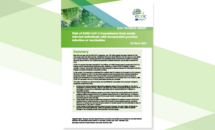Risk of SARS-CoV-2 transmission from newly-infected individuals with documented previous infection or vaccination
The aim of this document is to provide a summary of the available scientific evidence on the risk of SARS-CoV-2 transmission to susceptible contacts from infected individuals with documented previous infection or vaccination.
Executive Summary
More than one year into the SARS-CoV-2 pandemic, over 120 million people have been infected with the virus across more than 200 countries. Reinfections following natural infections with the same or a new SARSCoV-2 variant have been reported sporadically and questions remain concerning the duration of immunity following natural infection, and whether asymptomatic reinfected individuals may be able to transmit the virus.
COVID-19 vaccines have been evaluated for their efficacy and effectiveness against symptomatic COVID-19 infection and for reducing and/or preventing mild, moderate, or severe COVID-19 disease, including mortality. However, the vaccine trials have not been designed to measure reduction in transmission risk from infected vaccinated individuals to susceptible contacts.
In this context, it is important to understand the available scientific evidence on the extent to which previous SARS-CoV-2 infection or COVID-19 vaccination prevents onward transmission from infected individuals to susceptible contacts. Therefore, ECDC has conducted a review of published and pre-print literature on duration and characteristics of immunity following a natural SARS-CoV-2 infection due to any variant or after COVID-19 vaccination with any of the EU-authorised vaccines now available.
The review of evidence on natural immunity and possibilities for transmission from previously infected to susceptible contacts found that:
- Evidence from studies specifically designed to assess the impact of previous infection on the risk of transmission is currently lacking. Infection with SARS-CoV-2 does not provide sterilising immunity for all individuals and some who are reinfected might still be able to transmit SARS-CoV-2 infection to susceptible contacts.
- There is evidence that reinfection remains a rare event. Results from cohort studies confirm that the protective effect of previous SARS-CoV-2 infection ranges from 81% to 100% from Day 14 following initial infection, for a follow-up period of five to seven months. Protection against reinfection is lower in individuals aged 65 years and older.
- These studies were carried out before the emergence of SARS-CoV-2 variants of concern (VOCs) and therefore there is limited preliminary evidence that immunity induced against previously circulating SARS-CoV-2 variants may not have the same potency or duration against the VOCs identified to date (in particular the B.1.351 and P.1 variants.)
- As the number of individuals acquiring natural immunity increases, the total number of infections is expected to decrease significantly, leading to decreased transmission overall, unless the genetic changes in the circulating variants induce significant immune escape.
The review of evidence on immunity and possibilities for transmission from infected, previously-vaccinated individuals to susceptible contacts found that:
- Direct evidence of the impact of vaccination on the risk of transmission is only available from one study, a large register-based household transmission study from Scotland. This study suggests that vaccination of a household member reduces the risk of infection in susceptible household members by at least 30%.
- There is evidence that vaccination significantly reduces viral load and symptomatic/asymptomatic infections in vaccinated individuals, which could translate into reduced transmission, although the vaccine efficacy varies by vaccine product and target group. In light of this fact, the total number of infections is expected to decrease significantly as vaccination coverage increases, provided that there is a match between the vaccine strains and the circulating virus strains. This will lead to decreased transmission overall.
- Follow-up periods for vaccinated persons are not yet sufficiently long enough to draw conclusions on the duration of protection against infection long-term. Antibody titres in vaccinated individuals peak at 3−4 weeks following vaccination.
- Many of the vaccine efficacy studies were carried out before the emergence of SARS-CoV-2 VOCs. In studies that address the variants, there is limited preliminary evidence of reduced vaccine efficacy, in particular for B.1.351 and possibly also for P.1.
Follow-up of cohorts with previous SARS-CoV-2 infection and vaccination is needed to better assess the magnitude and duration of protection from reinfection leading to asymptomatic/symptomatic disease, and the effect of protection against further transmission to contacts.
As an RNA (ribonucleic acid) virus, SARS-CoV-2 will continue to evolve over time and its potential to escape human immune defences induced by natural infection or vaccination has already been documented. It is likely that in the future VOCs will continue to evolve and play a significant role in placing immunological pressure on the circulating viruses. It is not possible to predict when and where this will occur, however, cocirculation of the three VOCs (B.1.1.7, B.1.351 and P.1) has been noted in several EU/EEA countries.








